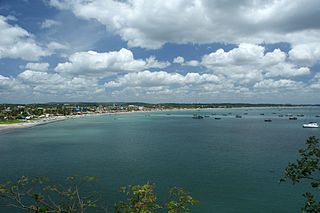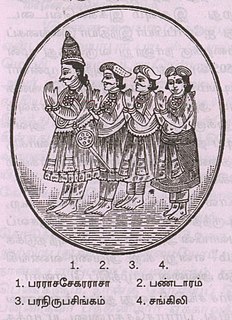
Trincomalee also known as Gokanna/Gokarna, is the administrative headquarters of the Trincomalee District and major resort port city of Eastern Province, Sri Lanka. Located on the east coast of the island overlooking the Trincomalee Harbour, 237 kilometres (147 mi) north-east of Colombo, 182 kilometres (113 mi) south-east of Jaffna and 111 kilometres (69 mi) miles north of Batticaloa, Trincomalee has been one of the main centres of Sri Lankan Tamil language speaking culture on the island for over two millennia. With a population of 99,135, the city is built on a peninsula of the same name, which divides its inner and outer harbours. People from Trincomalee are known as Trincomalians and the local authority is Trincomalee Urban Council. Trincomalee city is home to the famous Koneswaram temple from where it developed and earned its historic Tamil name Thirukonamalai. The town is home to other historical monuments such as the Bhadrakali Amman Temple, Trincomalee, the Trincomalee Hindu Cultural Hall and, opened in 1897, the Trincomalee Hindu College. Trincomalee is also the site of the Trincomalee railway station and an ancient ferry service to Jaffna and the south side of the harbour at Muttur.
The 'caste systems in Sri Lanka are social stratification systems found among the ethnic groups of the island since ancient times. The models are similar to those found in Continental India, but are less extensive and important for various reasons, although the caste systems still play an important and at least symbolic role in religion and politics. Sri Lanka is often considered to be a casteless or caste-blind society by Indians.

The Jaffna Kingdom, also known as Kingdom of Aryachakravarti, of modern northern Sri Lanka was a historic monarchy that came into existence around the town of Jaffna on the Jaffna peninsula. It was traditionally thought to be established after the invasion of Magha, who is credited with the founding of the Jaffna kingdom and is said to have been from Kalinga, in India. Established as a powerful force in the north, north east and west of the island, it eventually became a tribute-paying feudatory of the Pandyan Empire in modern South India in 1258, gaining independence in 1323, when the last Pandyan ruler of Madurai was defeated and expelled in 1323 by Malik Kafur, the army general of the Muslim Delhi Sultanate. For a brief period, in the early to mid-14th century, it was an ascendant power in the island of Sri Lanka when all regional kingdoms accepted subordination. However, the kingdom was eventually overpowered by the rival Kotte Kingdom, around 1450 when it was invaded by Prince Sapumal under the orders of Parakramabahu VI.

The Arya Chakravarti dynasty were kings of the Jaffna Kingdom in Sri Lanka. The earliest Sri Lankan sources, between 1277 and 1283, mention a military leader of this name as a minister in the services of the Pandyan Empire; he raided the western Sri Lankan coast and took the politically significant relic of the Buddha’s tooth from the Sinhalese capital city of Yapahuwa. Political and military leaders of the same family name left a number of inscriptions in the modern-day Tamil Nadu state, with dates ranging from 1272 to 1305, during the late Pandyan Empire. According to contemporary native literature, such as Cekaracecekaramalai, the family also claimed lineage from the Tamil Brahmins of the prominent Hindu pilgrimage temple of Rameswaram in the modern Ramanathapuram District of India. They ruled the Jaffna kingdom from the 13th until the 17th century, when the last of the dynasty, Cankili II, was ousted by the Portuguese.
Alagakkonara, also known as Alakeshwara, were a prominent feudal family that provided powerful ministers and military rulers during the medieval period in Sri Lanka. Although some historian say that the family was of Tamil origin originated from Madurai or Kanchipuram in Tamil Nadu, India. They arrived in Sri Lanka around the 13th century and naturalized themselves in Sri Lanka. One member of the family is noted for founding the current capital of Sri Lanka, Sri Jayawardenepura Kotte as a fort from which he waged a war against encroaching tax collectors from the Jaffna kingdom in the north. The family lost most of its influence after its leader was taken captive by the Ming Dynasty (Chinese) Admiral Zheng He in 1411.
Sri Lankan Tamil literature or Ceylon Tamil literature refers to Tamil literature produced in the current day country of Sri Lanka by various Tamil speaking communities such as the Sri Lankan Tamils, Indian Tamils of Sri Lanka and Sri Lankan Muslims. The earliest extant records survived from the Sangam age academies and continued in the medieval era in the courts of the Jaffna kingdom until modern times. The destruction of the Saraswathy Mahal library of Nallur and the burning of Jaffna library led to the loss of a large tract of Sri Lankan Tamil literature, although much survives through oral traditions and the unearthing and preservation of palm-leaf manuscripts, copper plate inscriptions & stone inscriptions.

Nainativu, is a small but notable island off the coast of Jaffna Peninsula in the Northern Province, Sri Lanka. The name of the island alludes to the folklore inhabitants, the Naga people. It is home to the Hindu shrine of Nagapooshani Amman Temple; one of the prominent 64 Shakti Peethas, and the Buddhist shrine Nagadeepa Purana Viharaya.
Vira Alakesvara, also known as Vijayabahu VI, was the last King of Gampola who ruled from 1397 to 1411. He was the last prominent member of the Alagakkonara family.
Martanda Cinkaiariyan ascended the throne of Jaffna Kingdom under the throne name Pararasasekaram III. He is one of the early Aryacakravarti kings about whom historical and epigraphical evidence is available. He was noted by Ibn Battuta in his well-known travelogue as well as he has left behind a few inscriptions. He oversaw the international trade of the Jaffna kingdom with Yemen via the kingdom's powerful trading ships. Martanda Cinkaiariyan accompanied Battuta to the peak of Sivanoli Padam Malai along with Yogis and other Hindus and companions of the king who visited the sacred Shiva site annually.

The Flag of the Jaffna Kingdom of the Aryacakravarti line of kings of Jaffna kingdom in northern Sri Lanka consisted of the couchant bull, the silver crescent moon with a golden sun. The single sacred conch shell, which spiral open to the right, and in the centre above the sacred bull, is a white parasol with golden tassels and white pearls. The color of the Royal Flag is saffron. The flag symbols are similar to number of flags found in India especially belonging to the Eastern Ganga dynasty. The Setu coins minted by the Aryacakravarti kings also have a similar symbol.

Setu coins or Setu bull coins are found in large quantities in the northern part of Sri Lanka and in Southern India. Codrington in his book Ceylon Coins and Currency published in 1924 and Mitchiner in his book Oriental Coins published in 1978 have clearly pointed out that the traditional design of Sri Lanka standing King Type Copper Massa (coins) of the Jaffna Kingdoms belongs to the Aryacakravarti dynasty from 1284 AD to 1410 AD. Setu coins were previously attributed to the Setupati Princes of Ramanathapuram in South India. There are two series one in the issued from the 13th to the 15th centuries and the other after the brief loss of sovereignty to the rival Kotte kingdom from 1450 to 1467 and reconstitution of the Kingdom. Even during the rule of Sapumal Kumaraya coins were issued in Jaffna that was distinct. Three types of this series are illustrated below. The obverse of these coins have a human figure flanked by lamps and the reverse has the Nandi (bull) symbol, the legend Sethu in Tamil with a crescent moon above.
Vanniar or Vanniyar was a title borne by chiefs in medieval Sri Lanka who ruled in the Chiefdom of Vavuni regions as tribute payers to the Jaffna vassal state. There are a number of origin theories for the feudal chiefs, coming from an indigenous formation. The most famous of the Vavni chieftains was Pandara Vannian, known for his resistance against the British colonial power.

The Vanni chieftaincies or Vanni principalities was a region between Anuradhapura and Jaffna, but also extending to along the eastern coast to Panama and Yala, during the Transitional and Kandyan periods of Sri Lanka. The heavily forested land was a collection of chieftaincies of principalities that were a collective buffer zone between the Jaffna Kingdom, in the north of Sri Lanka, and the Sinhalese kingdoms in the south. Traditionally the forest regions were ruled by Vedda rulers. Later on, the emergence of these chieftaincies were a direct result of the breakdown of central authority and the collapse of the Kingdom of Polonnaruwa in the 13th century, as well as the establishment of the Jaffna Kingdom in the Jaffna Peninsula. Control of this area was taken over by dispossessed Sinhalese nobles and chiefs of the South Indian military of Māgha of Kalinga (1215–1236), whose 1215 invasion of Polonnaruwa led to the kingdom's downfall. Sinhalese chieftaincies would lay on the northern border of the Sinhalese kingdom while the Tamil chieftaincies would border the Jaffna Kingdom and the remoter areas of the eastern coast, north western coast outside of the control of either kingdom.
Kulasekara Cinkaiariyan is considered to be the first of the Aryacakravarti dynasty kings to establish his rule over the Jaffna Kingdom in modern Sri Lanka.
Migapulle Arachchi also known as Chinna Migapillai, was a feudal lord from the Jaffna Kingdom who became a rebel leader just after its annexation by the Portuguese Empire in 1619. His title Arachchi, is a title given to the commanders of Lascarins or native military forces.
Bhuvanekabahu VI of Kotte, known also as Sapumal Kumaraya and Chempaka Perumal, was by self admission an adopted son of Parakramabahu VI whose principal achievement was the conquest of Jaffna Kingdom in the year 1447 or 1450. He ruled the kingdom for 17 years when he was apparently summoned to the south after the demise of his adopted father. According to a primary source Rajavaliya, he killed the grand son of Parakrama Bahu VI namely Vira Parakrama Bahu or Jaya Bahu but Do Couto, however, who was well-informed, says after a few years' reign the king died and his half-witted son was put on the throne by his aunt, who two years later finding herself unable to rule sent for Sapumal Kumaraya from Jaffna.

Nissanka Malla, also known as Keerti Nissanka and Kalinga Lokesvara was a king of Polonnaruwa who ruled the country from 1187 to 1196. He is known for his architectural constructions such as the Nissanka Lata Mandapaya, Hatadage and Rankot Vihara, as well as for the refurbishment of old temples and irrigation tanks.

Jaffna is the capital city of the Northern Province of Sri Lanka. It is the administrative headquarters of the Jaffna District located on a peninsula of the same name. With a population of 88,138 in 2012, Jaffna is Sri Lanka's 12th most populous city. Jaffna is approximately six miles from Kandarodai which served as an emporium in the Jaffna peninsula from classical antiquity. Jaffna's suburb Nallur, served as the capital of the four-century-long medieval Jaffna Kingdom.
When to date the start of the history of the Jaffna kingdom is debated among historians.

This is a bibliography of works on Sri Lanka.










